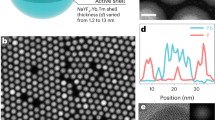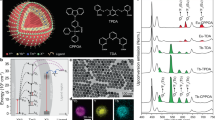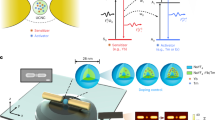Abstract
Upconversion nanocrystals have been extensively investigated for optical imaging and biomedical applications1,2. However, their photoluminescence is strongly attenuated by surface quenching as the nanocrystal size diminishes3. Despite considerable efforts4,5, the quenching mechanism remains poorly understood. Here we report that surface coordination of bidentate picolinic acid molecules to NaGdF4:Yb/Tm nanoparticles enhances four-photon upconversion by 11,000-fold. Mechanistic studies indicate that surface ligand coordination reconstructs orbital hybridization and crystal-field splitting, minimizing the energy difference between the 4f orbitals of surface and inner lanthanide sensitizers. The 4f-orbital energy resonance facilitates energy migration within the ytterbium sublattice, impeding energy diffusion to surface defects and ultimately enhancing energy transfer to the emitters. Moreover, ligand coordination can exert energy-level reconstruction with a ligand–sensitizer separation of over 2 nm. These findings offer insights into the development of highly emissive nanohybrids and provide a platform for constructing optical interrogation systems at single-particle levels.
This is a preview of subscription content, access via your institution
Access options
Access Nature and 54 other Nature Portfolio journals
Get Nature+, our best-value online-access subscription
$29.99 / 30 days
cancel any time
Subscribe to this journal
Receive 12 print issues and online access
$209.00 per year
only $17.42 per issue
Buy this article
- Purchase on Springer Link
- Instant access to full article PDF
Prices may be subject to local taxes which are calculated during checkout




Similar content being viewed by others
Data availability
All relevant data that support the findings of this work are available from the corresponding author on reasonable request.
Code availability
First-principles calculations were performed using the commercially available Vienna Ab initio Simulation Package. The codes used to calculate the distance between lanthanide ions and ligands are provided in the Supplementary Information.
References
Auzel, F. Upconversion and anti-Stokes processes with f and d ions in solids. Chem. Rev. 104, 139–174 (2004).
Zhou, J., Liu, Q., Feng, W., Sun, Y. & Li, F. Upconversion luminescent materials: advances and applications. Chem. Rev. 115, 395–465 (2015).
Gargas, D. J. et al. Engineering bright sub-10-nm upconverting nanocrystals for single-molecule imaging. Nat. Nanotechnol. 9, 300–305 (2014).
Rabouw, F. T. et al. Quenching pathways in NaYF4:Er3+,Yb3+ upconversion nanocrystals. ACS Nano 12, 4812–4823 (2018).
Mei, S. et al. Networking state of ytterbium ions probing the origin of luminescence quenching and activation in nanocrystals. Adv. Sci. 8, 2003325 (2021).
Bünzli, J.-C. G. & Piguet, C. Taking advantage of luminescent lanthanide ions. Chem. Soc. Rev. 34, 1048–1077 (2005).
Dong, H., Sun, L. D. & Yan, C. H. Energy transfer in lanthanide upconversion studies for extended optical applications. Chem. Soc. Rev. 44, 1608–1634 (2015).
Carneiro Neto, A. N., Moura, R. T. & Malta, O. L. On the mechanisms of nonradiative energy transfer between lanthanide ions: centrosymmetric systems. J. Lumin. 210, 342–347 (2019).
Shyichuk, A. et al. Energy transfer upconversion dynamics in YVO4:Yb3+,Er3+. J. Lumin. 170, 560–570 (2016).
Wu, S. et al. Non-blinking and photostable upconverted luminescence from single lanthanide-doped nanocrystals. Proc. Natl Acad. Sci. USA 106, 10917–10921 (2009).
Liu, Q. et al. Single upconversion nanoparticle imaging at sub-10 W cm−2 irradiance. Nat. Photonics 12, 548–553 (2018).
Lee, J. et al. Universal process-inert encoding architecture for polymer microparticles. Nat. Mater. 13, 524–529 (2014).
Bettinelli, M., Carlos, L. & Liu, X. Lanthanide-doped upconversion nanoparticles. Phys. Today 68, 38–44 (2015).
Chen, X. et al. Confining energy migration in upconversion nanoparticles towards deep ultraviolet lasing. Nat. Commun. 7, 10304 (2016).
Liu, Y. et al. Amplified stimulated emission in upconversion nanoparticles for super-resolution nanoscopy. Nature 543, 229–233 (2017).
Dong, H. et al. Lanthanide nanoparticles: from design toward bioimaging and therapy. Chem. Rev. 115, 10725–10815 (2015).
Fan, Y. et al. Lifetime-engineered NIR-II nanoparticles unlock multiplexed in vivo imaging. Nat. Nanotechnol. 13, 941–946 (2018).
Chen, S. et al. Near-infrared deep brain stimulation via upconversion nanoparticle-mediated optogenetics. Science 359, 679–684 (2018).
Chu, H., Zhao, J., Mi, Y., Di, Z. & Li, L. NIR-light-mediated spatially selective triggering of anti-tumor immunity via upconversion nanoparticle-based immunodevices. Nat. Commun. 10, 2839 (2019).
Quintanilla, M., Ren, F., Ma, D. & Vetrone, F. Light management in upconverting nanoparticles: ultrasmall core/shell architectures to tune the emission color. ACS Photonics 1, 662–669 (2014).
Zhang, Y. et al. Ultrasmall-superbright neodymium-upconversion nanoparticles via energy migration manipulation and lattice modification: 808 nm-activated drug release. ACS Nano 11, 2846–2857 (2017).
Bian, W. et al. Direct identification of surface defects and their influence on the optical characteristics of upconversion nanoparticles. ACS Nano 12, 3623–3628 (2018).
Ma, C. et al. Optimal sensitizer concentration in single upconversion nanocrystals. Nano Lett. 17, 2858–2864 (2017).
Wu, D. M., García-Etxarri, A., Salleo, A. & Dionne, J. A. Plasmon-enhanced upconversion. J. Phys. Chem. Lett. 5, 4020–4031 (2014).
Fernandez-Bravo, A. et al. Ultralow-threshold, continuous-wave upconverting lasing from subwavelength plasmons. Nat. Mater. 18, 1172–1176 (2019).
Zhao, J. et al. Single-nanocrystal sensitivity achieved by enhanced upconversion luminescence. Nat. Nanotechnol. 8, 729–734 (2013).
Liang, L. et al. Upconversion amplification through dielectric superlensing modulation. Nat. Commun. 10, 1391 (2019).
Strange, P., Svane, A., Temmerman, W. M., Szotec, Z. & Winter, H. Understanding the valency of rare earths from first-principles theory. Nature 399, 756–758 (1999).
Zhou, J. et al. Activation of the surface dark-layer to enhance upconversion in a thermal field. Nat. Photonics 12, 154–158 (2018).
Blasse, G. Energy migration in rare-earth compounds. Recl. Trav. Chim. Pays Bas 105, 143–149 (1986).
Zuo, J. et al. Precisely tailoring upconversion dynamics via energy migration in core–shell nanostructures. Angew. Chem. Int. Ed. 57, 3054–3058 (2018).
Chen, X. et al. Energy migration upconversion in Ce(III)-doped heterogeneous core–shell–shell nanoparticles. Small 13, 1701479 (2017).
Garfield, D. J. et al. Enrichment of molecular antenna triplets amplifies upconverting nanoparticle emission. Nat. Photonics 12, 402–407 (2018).
Han, S. et al. Lanthanide-doped inorganic nanoparticles turn molecular triplet excitons bright. Nature 587, 594–599 (2020).
Bünzli, J. C. G. On the design of highly luminescent lanthanide complexes. Coord. Chem. Rev. 293–294, 19–47 (2015).
Johnson, N. J. J., Korinek, A., Dong, C. & van Veggel, F. C. J. M. Self-focusing by Ostwald ripening: a strategy for layer-by-layer epitaxial growth on upconverting nanocrystals. J. Am. Chem. Soc. 134, 11068–11071 (2012).
Kresse, G. & Furthmüller, J. Efficiency of ab-initio total energy calculations for metals and semiconductors using a plane-wave basis set. Comput. Mater. Sci. 6, 15–50 (1996).
Acknowledgements
X.L. acknowledges support from the NUS NANONASH Programme (NUHSRO/2020/002/NanoNash/LOA; R143000B43114), the Singapore Ministry of Education (MOE2017-T2-2-110) and the Agency for Science, Technology and Research (A*STAR) (grant no. A1883c0011). H.X. acknowledges support from the National Natural Science Foundation of China (NSFC) (grant no. 92061205) and Young Innovative Team Supporting Projects of Heilongjiang Province.
Author information
Authors and Affiliations
Contributions
H.X., X.Q. and X.L. conceived, designed and supervised the project and led the collaboration efforts. H.X. and S.H. synthesized the nanocrystals and conducted the optical experiments with contributions from R.D., Q.S. and Y.T. Quantum mechanical calculations were conducted by X.Q. Monte Carlo simulations were performed by Y.W. The manuscript was written by H.X., X.Q., S.H. and X.L. All authors participated in the discussion and analysis of the manuscript.
Corresponding authors
Ethics declarations
Competing interests
The authors declare no competing interests.
Additional information
Peer review information Nature Photonics thanks Marco Bettinelli, Dayong Jin and the other, anonymous, reviewer(s) for their contribution to the peer review of this work.
Publisher’s note Springer Nature remains neutral with regard to jurisdictional claims in published maps and institutional affiliations.
Supplementary information
Supplementary Information
Materials and methods, Discussion, Schemes 1–3, Figs. 1–26, Tables 1–5 and refs. 1–10.
Rights and permissions
About this article
Cite this article
Xu, H., Han, S., Deng, R. et al. Anomalous upconversion amplification induced by surface reconstruction in lanthanide sublattices. Nat. Photon. 15, 732–737 (2021). https://doi.org/10.1038/s41566-021-00862-3
Received:
Accepted:
Published:
Issue Date:
DOI: https://doi.org/10.1038/s41566-021-00862-3
This article is cited by
-
Dynamic manipulation of multimodal emission in Er3+-activated non-core–shell structure for optical thermometry and information security
Rare Metals (2024)
-
Ultra-wideband-responsive photon conversion through co-sensitization in lanthanide nanocrystals
Nature Communications (2023)
-
Concentration-induced morphological changes of biocompatible La3+, Yb3+, Er3+ tri-doped NaYF4 compounds
Applied Physics A (2023)
-
Investigation of Upconversion Luminescence Attenuation in Aqueous Solutions Under 980 nm and 808 nm Irradiation
Journal of Analysis and Testing (2023)
-
Enhancing light yield of Tb3+-doped fluoride nanoscintillator with restricted positive hysteresis for low-dose high-resolution X-ray imaging
Nano Research (2023)



